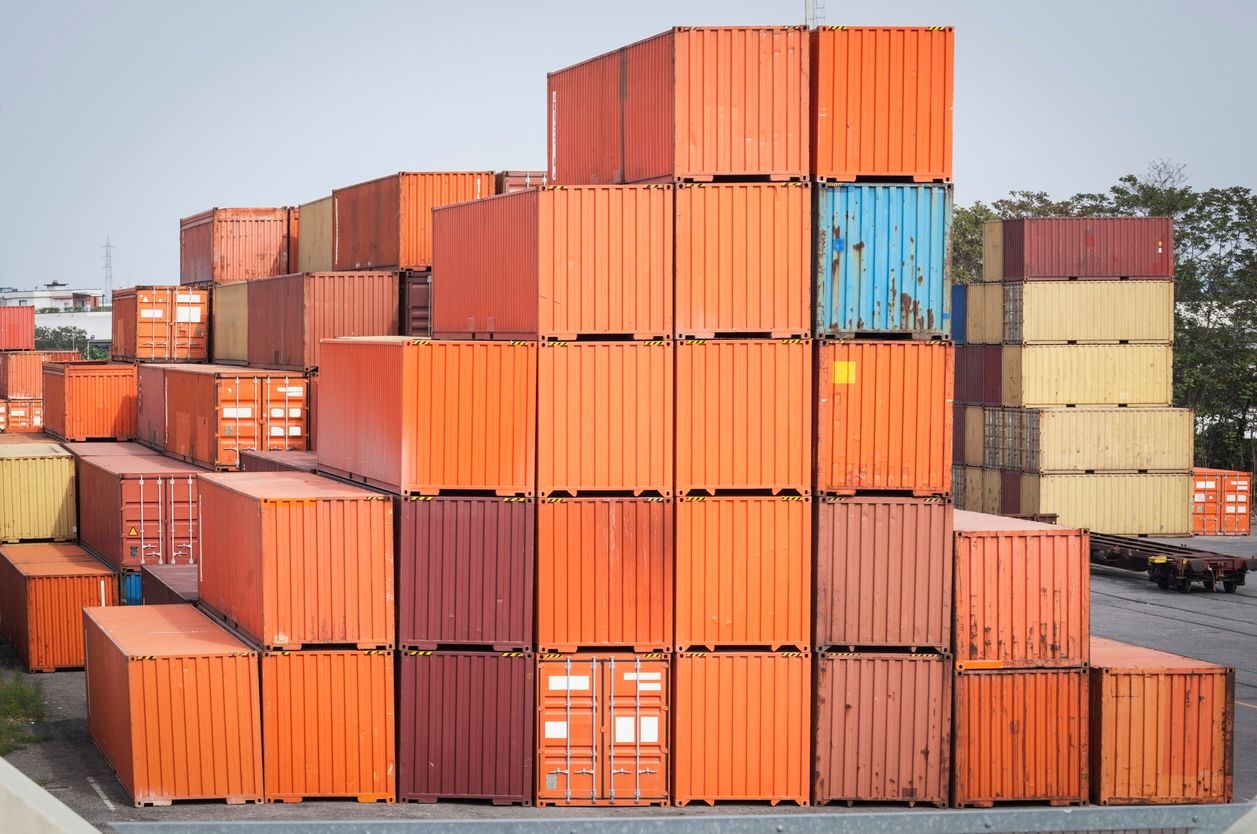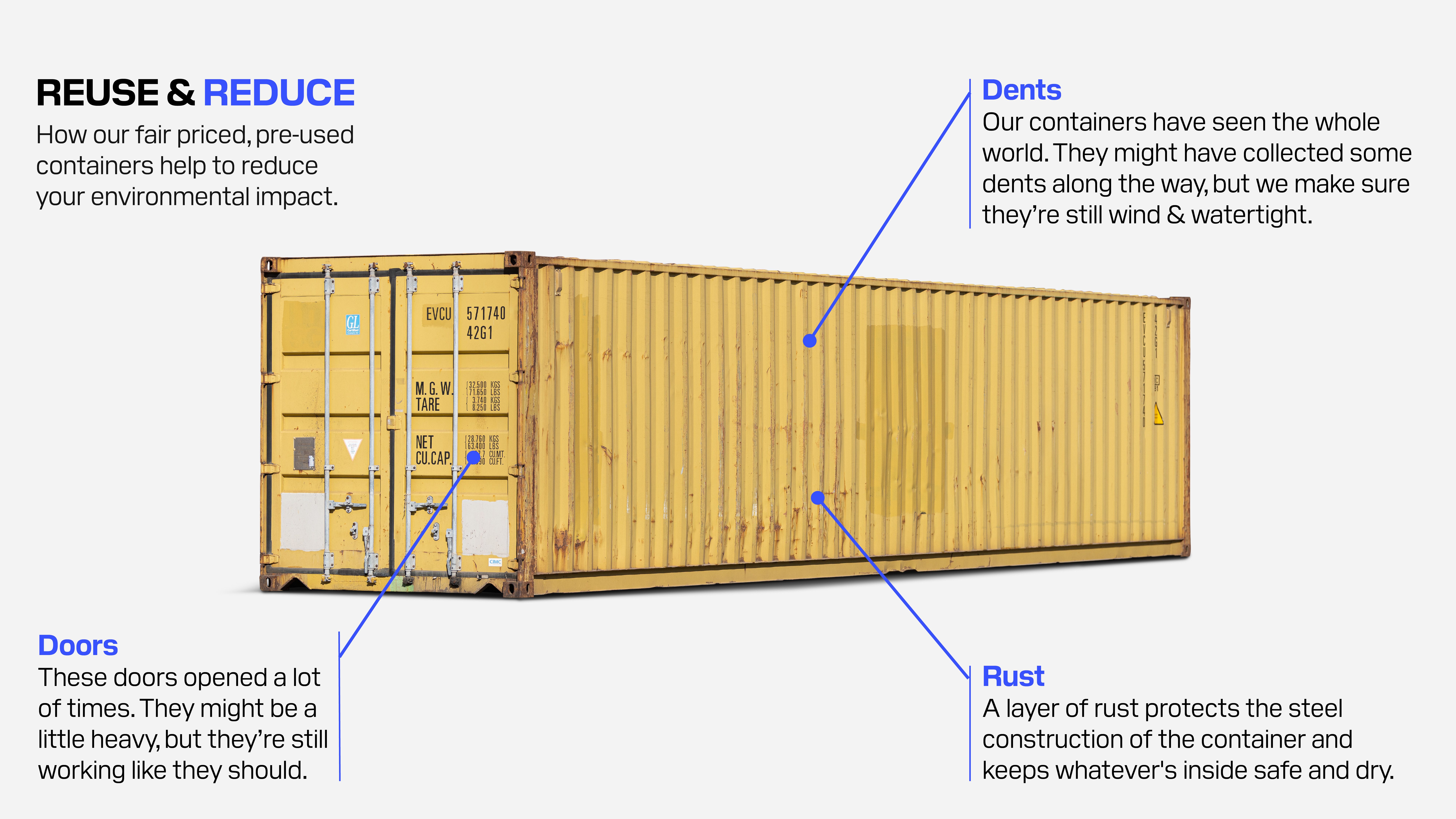SPRING SALE: Receive $100 Off Per Container
Are Rusty Used Containers as Strong as New Containers?
Understand rust and how it affects the structural integrity and durability of used shipping containers.


Rust is often misunderstood, viewed as a sign of decay or deterioration. However, when it comes to shipping containers, rust is not necessarily a flaw but rather a natural patina that doesn’t compromise the structure or its function. Just as an old brick or truck with a well-earned patina tells a story of resilience and craftsmanship, a shipping container adorned with rust reflects its durability and journey through time.

Rust: A Natural Patina That Enhances the Character of Shipping Containers
While we recognize that there are plenty of items that you wish not to purchase with rust (a bike, pipes for plumbing, a cast iron pan) a Corten Steel made for oceanic transport and secure global trade logistics, is perfectly functional with a little sign of aging.
The Science Behind Rust
As many learn in grade school, rust is a chemical reaction known as oxidation. It occurs when iron or iron-containing alloys, such as steel, react with oxygen and water, forming iron oxide—the substance responsible for rust. The rate at which rust develops depends on factors like humidity, temperature, and exposure to salts. Because all shipping containers originate from China and undergo oceanic transport, rust is extremely common regardless of their age.

Rust and Structural Integrity
Shipping containers are built to withstand the harshest environments, from the salty sea air to extreme temperature variations. Made from Corten steel, also known as weathering steel, these containers are specifically designed to develop a stable, protective layer of rust. Unlike ordinary rust that weakens metal, the patina formed on Corten steel acts as a shield, slowing down further corrosion and maintaining the structural integrity of the container. This controlled oxidation process ensures that the container remains strong and functional for years, even with visible rust on its surface.
The Beauty of Rust: Aged and Timeless
Just like an old truck that proudly wears its weathered paint and rusted spots as a badge of honor, a shipping container with a rusty exterior tells a story of endurance and reliability. Rather than being seen as a flaw, rust should be embraced as a natural element that adds character. Each patch of rust is unique, creating an organic pattern that highlights the journey the container has taken, whether it has traveled across the world or served as a reliable storage unit.
Rust as a Mark of Quality
A rusted surface doesn’t mean a shipping container was poorly made; in fact, it often indicates the opposite. A well-built container ages gracefully, just as classic vehicles with strong steel bodies do. The presence of rust signifies that the steel was robust enough to last long enough to develop this natural patina. Unlike cheaply made materials that corrode beyond repair, high-quality steel develops rust in a way that preserves rather than destroys.
Embracing Rust in Design and Repurposing
With the growing trend of repurposing shipping containers into onsite mobile offices, and creative spaces, many designers and architects intentionally leave the rust intact to maintain an industrial aesthetic. The rustic appeal of aged metal adds depth, warmth, and authenticity to a structure, proving that rust is not something to be hidden but celebrated. It tells a story, provides texture, and enhances the visual appeal of repurposed containers.
Rust is not a sign of weakness
It is a testament to strength, durability, and history! In the case of shipping containers, rust does not compromise function but instead showcases the resilience and craftsmanship of these steel structures. Just as an old, well-loved truck proudly wears its rust as a sign of a life well-lived, a rusted shipping container tells a story of endurance. Instead of fearing rust, we should appreciate it as nature’s way of adding character and preserving the essence of well-made materials.
To explore others treasures that were built to last, check out 29 Palms Inn in California. The generational owners, the Grunt Family, shared that “the best things here at 29 Palms Inn, are the oldest. They were built to last.”
Ready to see past the imperfections? Explore a rusty 20ft or 40ft decommissioned shipping container for storage or creative building!
Frequently Asked Questions
"Wind and watertight" (WWT) is a term commonly used to describe the condition of a shipping container or structure. It means that:
**Windproof **– The container or structure is sealed against wind penetration, preventing drafts or air leakage. **Watertight **– It does not allow water to enter, protecting the contents from rain, leaks, and moisture.
However, "wind and watertight" does not necessarily mean the container is in perfect condition. It may have cosmetic damage like dents, rust, or scratches, but it will still keep out wind and water. This classification is often used for second-hand shipping containers that are no longer suitable for cargo transport but are still usable for storage or other purposes.
Unfortunatley, due to safety and security it is not possible for you to pick your color container. The way the containers are stacked at the depot make it difficult to pick. Also the carrier is asked to pick the quality over the color during inpection. Please note most used containers will have a faded patina due to time as sea and are more commonly are orange, red, white, blue and yellow.
The history of the shipping container is a fascinating story of innovation that revolutionized global trade. Here’s a breakdown of its key developments:
Early Shipping Methods
- Before shipping containers, cargo was transported in a process called break-bulk shipping. Goods were manually loaded and unloaded piece by piece into ships, which was slow, labor-intensive, and prone to theft or damage.
The Birth of the Modern Shipping Container (1950s)
- A U.S. trucking entrepreneur, Malcolm McLean, is credited with inventing the modern intermodal shipping container. He realized that instead of handling cargo individually, it would be more efficient to transport goods in standardized, stackable containers.
- In 1956, McLean launched the Ideal-X, a converted oil tanker carrying 58 of his new containers from New Jersey to Texas. This event marked the beginning of containerized shipping.
Standardization and Global Adoption (1960s-1970s)
- In 1961, the International Organization for Standardization (ISO) set global standards for shipping containers, ensuring they could be used worldwide.
- Container ports and specialized cranes were built to handle the new system, drastically reducing loading times from days to just hours.
- The Vietnam War played a role in expanding container use, as the U.S. military adopted them for efficient transport.
Shipping Boom and Globalization (1980s-Present)
- Container shipping drove globalization, making goods cheaper and more accessible.
- The rise of megaships, such as the Maersk Triple E class, allowed for even greater efficiency.
- Smart containers with tracking technology are now improving logistics further.
Impact of the Shipping Container
- Dramatically lowered shipping costs, making international trade more efficient.
- Enabled globalization, allowing manufacturers to produce goods in lower-cost regions.
- Revolutionized supply chains, leading to the modern retail and e-commerce industries.
- Today, over 90% of global trade moves by sea, with billions of containers transported each year. The humble shipping container continues to shape the world economy, proving that a simple idea can have an enormous impact.

